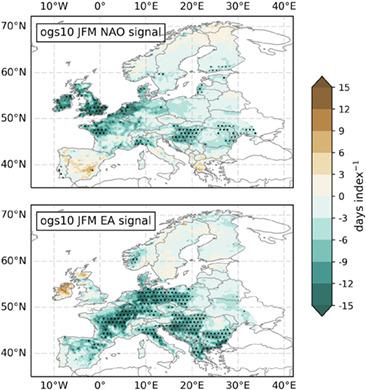当前位置:
X-MOL 学术
›
Int. J. Climatol.
›
论文详情
Our official English website, www.x-mol.net, welcomes your
feedback! (Note: you will need to create a separate account there.)
The role of teleconnection patterns in the variability and trends of growing season indices across Europe
International Journal of Climatology ( IF 3.5 ) Pub Date : 2021-07-08 , DOI: 10.1002/joc.7290 Philip M. Craig 1, 2 , Richard P. Allan 1, 3
International Journal of Climatology ( IF 3.5 ) Pub Date : 2021-07-08 , DOI: 10.1002/joc.7290 Philip M. Craig 1, 2 , Richard P. Allan 1, 3
Affiliation

|
Teleconnection patterns affect the weather and climate on both interannual and decadal timescales which in turn affects various socio-economic sectors such as agriculture. We use three climate indices based on E-OBS data from the INDECIS dataset (growing season onset [ogs10], growing season rainfall [gsr] and growing season temperature [ta_o]) to assess the interannual variability and trends over 1950–2017 associated with four teleconnection patterns (North Atlantic Oscillation [NAO], East Atlantic pattern [EA], Scandinavian pattern [SCA] and East Atlantic/West Russia pattern [EAWR]) using linear regression to extract the signal of each teleconnection pattern and their contribution to interannual variability. Trends towards an earlier growing season onset are found across most of Europe in low-lying regions. The NAO dominates interannual variability in northwest Europe where an NAO index of 1 is associated with earlier ogs10 of about 10 days and the EA dominates the continent with a trend towards the positive EA phase driving an earlier growing season onset of 1.1–1.7 days·decade−1 in five regions (Great Britain and Ireland, France, Italy, Poland and North Germany, Hungary, Balkans). The EA and SCA gsr signals have north/south splits of orientation: positive EA is linked to increased gsr in northern regions and reduced gsr in southern Europe, and vice versa for SCA. Correlations between gsr interannual variability and the teleconnection contributions are strongest in the Mediterranean regions and south Scandinavia with maxima of 0.41 and 0.46, respectively. Decreasing ta_o trends in Romania are explained by poor data coverage causing problems with the EOBS gridding algorithm when new stations are incorporated from 1961. The net effect is that Romanian ta_o is about 1.5°C cooler than expected compared to trends from surrounding countries. Improved spatial and temporal data coverage will benefit the EOBS dataset and prevent such erroneous trends.
中文翻译:

遥相关模式在整个欧洲生长季节指数的变化和趋势中的作用
遥相关模式在年际和年代际时间尺度上影响天气和气候,进而影响农业等各种社会经济部门。我们使用基于来自 INDECIS 数据集的 E-OBS 数据的三个气候指数(生长季节开始 [ogs10]、生长季节降雨量 [gsr] 和生长季节温度 [ta_o])来评估 1950-2017 年与四种遥相关模式(北大西洋涛动 [NAO]、东大西洋模式 [EA]、斯堪的纳维亚模式 [SCA] 和东大西洋/俄罗斯西部模式 [EAWR])使用线性回归提取每个遥相关模式的信号及其对年际的贡献变化性。在欧洲大部分低洼地区发现了生长季节开始提前的趋势。-1在五个地区(英国和爱尔兰、法国、意大利、波兰和德国北部、匈牙利、巴尔干)。EA 和 SCA gsr 信号具有南北方向的分裂:正 EA 与北部地区 gsr 增加和南欧 gsr 减少有关,反之亦然。gsr 年际变率与遥相关贡献之间的相关性在地中海地区和斯堪的纳维亚南部最强,最大值分别为 0.41 和 0.46。罗马尼亚 ta_o 趋势下降的原因是数据覆盖率低,导致 1961 年开始并入新站时 EOBS 网格算法出现问题。净效应是,与周边国家的趋势相比,罗马尼亚 ta_o 比预期的温度低约 1.5°C。
更新日期:2021-07-08
中文翻译:

遥相关模式在整个欧洲生长季节指数的变化和趋势中的作用
遥相关模式在年际和年代际时间尺度上影响天气和气候,进而影响农业等各种社会经济部门。我们使用基于来自 INDECIS 数据集的 E-OBS 数据的三个气候指数(生长季节开始 [ogs10]、生长季节降雨量 [gsr] 和生长季节温度 [ta_o])来评估 1950-2017 年与四种遥相关模式(北大西洋涛动 [NAO]、东大西洋模式 [EA]、斯堪的纳维亚模式 [SCA] 和东大西洋/俄罗斯西部模式 [EAWR])使用线性回归提取每个遥相关模式的信号及其对年际的贡献变化性。在欧洲大部分低洼地区发现了生长季节开始提前的趋势。-1在五个地区(英国和爱尔兰、法国、意大利、波兰和德国北部、匈牙利、巴尔干)。EA 和 SCA gsr 信号具有南北方向的分裂:正 EA 与北部地区 gsr 增加和南欧 gsr 减少有关,反之亦然。gsr 年际变率与遥相关贡献之间的相关性在地中海地区和斯堪的纳维亚南部最强,最大值分别为 0.41 和 0.46。罗马尼亚 ta_o 趋势下降的原因是数据覆盖率低,导致 1961 年开始并入新站时 EOBS 网格算法出现问题。净效应是,与周边国家的趋势相比,罗马尼亚 ta_o 比预期的温度低约 1.5°C。











































 京公网安备 11010802027423号
京公网安备 11010802027423号